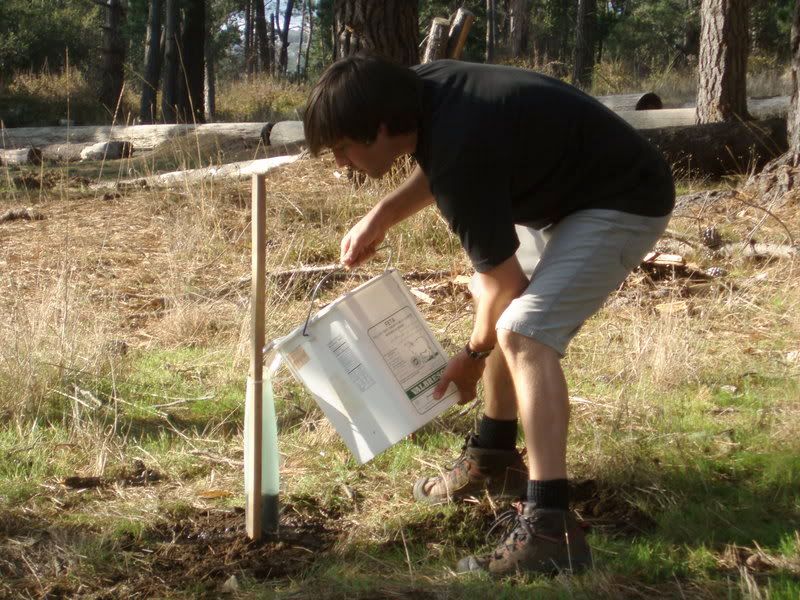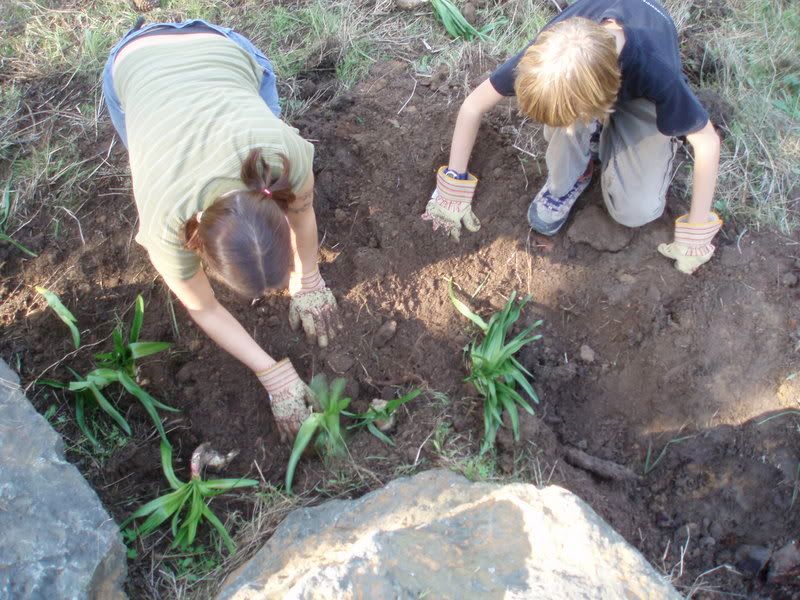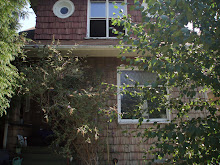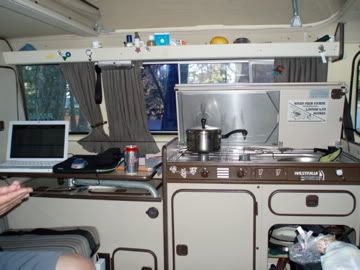
“They’re use to being on top,” Chris tells us. He’s the director of the camp and has a science-related love affair with the forest and marine ecosystems. He gestures towards the sky, demonstrating that oaks usually dominate the forest canopy. Not here. Along this stretch of the coast they’re dwarfed by the pines. Monterey Pines living in the southern tip of their range. But the pines too, are out of their element. The heat’s too much for them. It’s 75 degrees and Chris tells us, “They think they’re going to die.” They’re cracking up, literally. We listen as the pinecones pop, unwinding in a Fibonacci twirl. Pine seed helicopters litter the ground. It’s their effort against extinction- the possibility of a next generation. Meanwhile, the 17 redwood seedlings are holding on despite a lack of water. Last year, Chris picked up a couple dozen free; leftovers from a forest service project a few hundred miles north. Ironically, life in this forest is entirely comfortable for the South American amaryllis- who spread gracefully by seed and bulb production.

As volunteers here, we’re advocates for this forest of misfits. Not many pine seeds will manage to evade the quail, squirrel and mice. So we collect and roast pinecones, harvesting seeds at a safe distance from the birds. We wrote a grant, seeking county funds for equipment for a pine tree nursery. In ten years, these babies will tower the mighty 60-year-old oaks. Until a windstorm topples them. Without a taproot, they’ll sway, shutter and collapse. On an oak. Who for decades has struggled in the shadows. Whose acorns have been devoured by rodents and whose offshoots are continually mowed by the deer.

The camp was run under a YMCA/Elks Club partnership for some years. I’ve given tours to seniors who tell me they were counselors here in the late 40’s. At some point, the camp fell on hard times and the YMCA wanted $200,000/year to continue to host it. The two are no longer affiliated. Outdoor education is the focus of the revived, independent camp. And while the oak, pine and redwoods face some challenges here, 3,000+ kids will thrive here this thie year. Chris really doesn’t want to include flowers from another continent in their hands-on lessons about the watershed. We’ve removed about 600 amaryllis belladonna bulbs. We'd be happy to pack them in peat send some to you. Just don't go planting them in a native forest outside of Argentina.
 “They’re use to being on top,” Chris tells us. He’s the director of the camp and has a science-related love affair with the forest and marine ecosystems. He gestures towards the sky, demonstrating that oaks usually dominate the forest canopy. Not here. Along this stretch of the coast they’re dwarfed by the pines. Monterey Pines living in the southern tip of their range. But the pines too, are out of their element. The heat’s too much for them. It’s 75 degrees and Chris tells us, “They think they’re going to die.” They’re cracking up, literally. We listen as the pinecones pop, unwinding in a Fibonacci twirl. Pine seed helicopters litter the ground. It’s their effort against extinction- the possibility of a next generation. Meanwhile, the 17 redwood seedlings are holding on despite a lack of water. Last year, Chris picked up a couple dozen free; leftovers from a forest service project a few hundred miles north. Ironically, life in this forest is entirely comfortable for the South American amaryllis- who spread gracefully by seed and bulb production.
“They’re use to being on top,” Chris tells us. He’s the director of the camp and has a science-related love affair with the forest and marine ecosystems. He gestures towards the sky, demonstrating that oaks usually dominate the forest canopy. Not here. Along this stretch of the coast they’re dwarfed by the pines. Monterey Pines living in the southern tip of their range. But the pines too, are out of their element. The heat’s too much for them. It’s 75 degrees and Chris tells us, “They think they’re going to die.” They’re cracking up, literally. We listen as the pinecones pop, unwinding in a Fibonacci twirl. Pine seed helicopters litter the ground. It’s their effort against extinction- the possibility of a next generation. Meanwhile, the 17 redwood seedlings are holding on despite a lack of water. Last year, Chris picked up a couple dozen free; leftovers from a forest service project a few hundred miles north. Ironically, life in this forest is entirely comfortable for the South American amaryllis- who spread gracefully by seed and bulb production. As volunteers here, we’re advocates for this forest of misfits. Not many pine seeds will manage to evade the quail, squirrel and mice. So we collect and roast pinecones, harvesting seeds at a safe distance from the birds. We wrote a grant, seeking county funds for equipment for a pine tree nursery. In ten years, these babies will tower the mighty 60-year-old oaks. Until a windstorm topples them. Without a taproot, they’ll sway, shutter and collapse. On an oak. Who for decades has struggled in the shadows. Whose acorns have been devoured by rodents and whose offshoots are continually mowed by the deer.
As volunteers here, we’re advocates for this forest of misfits. Not many pine seeds will manage to evade the quail, squirrel and mice. So we collect and roast pinecones, harvesting seeds at a safe distance from the birds. We wrote a grant, seeking county funds for equipment for a pine tree nursery. In ten years, these babies will tower the mighty 60-year-old oaks. Until a windstorm topples them. Without a taproot, they’ll sway, shutter and collapse. On an oak. Who for decades has struggled in the shadows. Whose acorns have been devoured by rodents and whose offshoots are continually mowed by the deer.  The camp was run under a YMCA/Elks Club partnership for some years. I’ve given tours to seniors who tell me they were counselors here in the late 40’s. At some point, the camp fell on hard times and the YMCA wanted $200,000/year to continue to host it. The two are no longer affiliated. Outdoor education is the focus of the revived, independent camp. And while the oak, pine and redwoods face some challenges here, 3,000+ kids will thrive here this thie year. Chris really doesn’t want to include flowers from another continent in their hands-on lessons about the watershed. We’ve removed about 600 amaryllis belladonna bulbs. We'd be happy to pack them in peat send some to you. Just don't go planting them in a native forest outside of Argentina.
The camp was run under a YMCA/Elks Club partnership for some years. I’ve given tours to seniors who tell me they were counselors here in the late 40’s. At some point, the camp fell on hard times and the YMCA wanted $200,000/year to continue to host it. The two are no longer affiliated. Outdoor education is the focus of the revived, independent camp. And while the oak, pine and redwoods face some challenges here, 3,000+ kids will thrive here this thie year. Chris really doesn’t want to include flowers from another continent in their hands-on lessons about the watershed. We’ve removed about 600 amaryllis belladonna bulbs. We'd be happy to pack them in peat send some to you. Just don't go planting them in a native forest outside of Argentina.




No comments:
Post a Comment